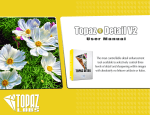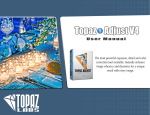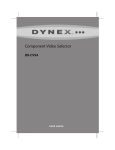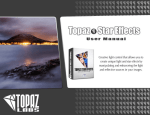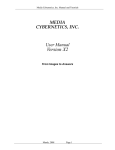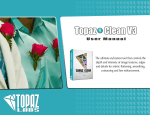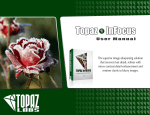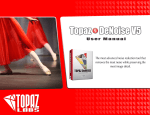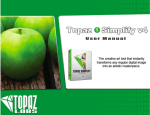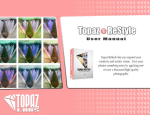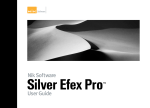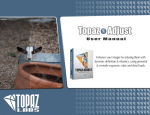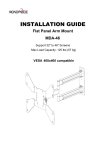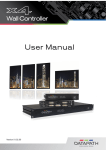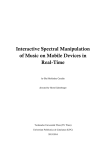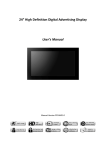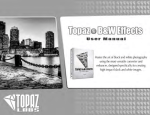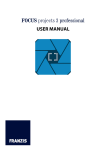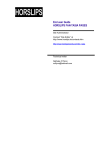Download Topaz Detail V3
Transcript
Topaz Detail V3 User Manual The most controllable detail enhancement tool avaliable to selectively control three levels of detail and sharpening within images with absolutely no leftover artifacts or halos. Contents Topaz Detail User Manual I. Installation A. How to Install B. Host-Specific Installation II. Introduction A. Topaz Detail... 1. About Topaz Detail... 2. Primary Functions B. How Detail Works C. New Features .3 4 7 7 7 ...9 9 III. Work Area A. Interface .11 B. Preview 15 Presets 17 1. Applying Presets 17 2. Adding Presets 17 3. Deleting Presets 18 4. Importing Presets 19 5. Exporting Presets 19 6. Sharing Presets 19 D. Tools 18 E. Menu 21 1. Preferences 21 2. Enable Tool Tips.. 21 3. Enable Auto Update 21 4. Enter Key ....21 5. What’s This? .21 6. Tech Support......................................21 7. Product Info........................................21 8. Gallery .....21 9.Tutorials 21 10.About 21 IV. Settings & Parameters A. Pre-Processing.................................................22 B. Effects & Presets..............................................23 C. Parameters.......................................................23 D. Detail................................................................24 E. Tone..................................................................25 F. Color.................................................................26 G. Deblur...............................................................27 H. Effect Mask......................................................27 VI. Work Flow A. Sample Project..... .29 VII. Additional Resources A. Glossary B. FAQ’s C. Shortcut Keys D. Connect E. Company Info F. Product Line ..35 36 .38 .39 .40 ...41 2 Installation Topaz Detail User Manual Topaz Detail is a Photoshop plug-in, which means it won’t run by itself and requires a compatible host program. To Install 1. Close Photoshop or other image editing program if you are using it. 2. Open the Topaz Detail zip file, double-click on the Topaz Detail installer, and then follow the on-screen instructions. Important: Please note that you will not be able to import your Detail 2 prestets into Detail 3. Since Detail 3 uses a new and improved technology, your Detail 2 presets will not be compatible with Detail 3. When you install Detail 3 it will not automatically uninstall Detail 2, so you will still have access to your Detail 2 presets. Entering Your Key Entering your trial key allows you to save your projects and print them during your evaluation period. Entering your license key allows you do the same, except without any time limitations. 1. Start by opening up an image in Photoshop. 2. Go to Filters -> Topaz Labs -> Detail 3 -> Menu -> Enter key. 3. Your Topaz plug-ins will automatically be installed in your Photoshop plug-ins folder. 4. After the installation, you will need to enter your license or trial key. Important for Mac Users: After installation, Topaz Detail will be installed in the following folder: “ HD -> Library -> Application Support -> Topaz Labs -> Detail 3”. If your Photoshop is installed in a customized location, you will need to manually create a shortcut (alias) link inside folder “<Photoshop install folder> -> Plug-ins” that links to “ HD -> Library -> Application Support -> Topaz Labs -> Detail 3 -> Plug-ins”. 3. You can then copy and paste or type your key in. Host-Specific Installation Topaz Detail is also compatible with Lightroom, Aperture and iPhoto. To use Detail in any of these programs you will need to download and install the free Topaz Fusion Express plug-in. You can get it online at: www. topazlabs.com/downloads In Windows, Topaz Detail is supported by most host applications that support Photoshop plug-ins. This includes Paint Shop Pro, Photo Impact, Painter, and Irfanview, although there are also other host programs that may also support Topaz Detail. Then, to configure it into each program, follow the host-specific instructions on the next page. 3 Topaz Detail User Manual How to install Topaz Detail in Paintshop Pro 1. First launch PaintShop Pro / Photo Impact. Installation 3. Choose C:\Program Files\Topaz Labs\Topaz Detail 3 plug-ins and click “OK”. 2. Go to Menu file -> Preferences -> File Locations. Select “Plugins” from the “File Types” list and click “Add”. 4 4. Topaz Detail 3 is now available to use. Simply go to Effects -> Plug-ins and select “Topaz Detail 3”. Topaz Detail User Manual How to install Topaz Detail in Photo Impact 1. First launch Photo Impact. 2. Go to File -> Preferences -> General or use shortcut key F6. Installation Then click on the button and browse to find the Detail plug-in folder located in: C:\Program Files\Topaz Labs\Topaz Detail 3 plug-ins and then click “OK”. 5 3. Select Plug-ins from the Categories list. 4. Restart Photo Impact. Go to Menu -> Effect to access plug-in. Topaz Detail User Manual How to install Topaz Detail in Irfanview 1. Make sure that you have downloaded and installed the 8bf plug-in add-on, available on the Irfanview webpage. (http://www.software.com/irfanview-plugin) Installation 3. In the screen that pops up, select “Add 8BF filters” and navigate to the C:\Program Files\Topaz Labs\Topaz Detail 3\Plug-ins folder and click “OK”. You will then see “Topaz Detail 3” in the Available/Loadable 8BF Filters section. 2. Open Irfanview and go to Image -> Effects -> Adobe 8BF filters. 6 4. To use Topaz Detail 3 in the future, simply go to Image -> Effects> Adobe 8BF filters again and select “Topaz Detail 3”. Introduction Topaz Detail User Manual Topaz Detail About Topaz Detail Topaz Detail™ features the most advanced detail control technology, allowing for precise and intricate enhancements to multiple sizes of detail (small, medium and large) within your images – but without the side effects of halos and artifacts. The flexible and unmatched detail control found in Topaz Detail is invaluable for photographers that desire the ability to make high-quality detail enhancements. Topaz Detail uses sophisticated algorithms that allow the user to quickly and effectively improve any image without spending a lot of time tweaking settings or making adjustment layers. It also includes several built-in presets that serve as a starting point for many images. Topaz Detail gives you ultimate control over small, medium and large image details, tone, contrast and color offering unprecedented control over the enhancement photos. The Primary Functions of Topaz Detail Include: 1. Dynamically enhance large image details to give images depth and more oveall appeal. 2. Intelligent small detail enhancement / reduction with innovative detail manipulation functions. before Topaz Detail 3. Unique color effects via advanced color processing. 4. Advanced tone adjustment features that allow for individual RGB, shadow, highlight, brightness and contrast balancing. 5. Reduce minor instances of blur in images for better overall detail and sharpening enhancements. after Topaz Detail 7 Introduction Contents User Manual Topaz Detail How Detail Works Walk through the internal steps that Topaz Detail takes from start to finish. 8 1. Start with your original image. Invoke Topaz Detail. break- through technological algorithms.) 2. Pre-processing starts. Topaz Detail separates your image into two. One based on chrominance (color information) and one based on luminance (grayscale information). These will undergo different processing methods and will be affected by different sliders. 4. The user adjusts the large, medium, and small detail sizes, and each individual detail layer is affected appropriately. If you like, you can see what each of the four individual layers looks like. To see the base layer by itself, turn the large, medium, and small sliders. To see each individual detail size layer, drag that particular one all the way to the right and set the con- trast to 0 (which will switch the base layer to neutral gray). 3. The luminance information is further internally broken down into three detail layers based on size, and a base layer. Manipulating these four layers make up the bulk of the detail enhancement functionality of the software. After this step, pre-processing ends and the Topaz Detail user interface pops up. (This is also the portion of pre-processing that runs the slowest... probably because it has the most advanced 5. The luminance layer is re-combined with the adjusted small, medium, and large detail layers as well as the base layer. Introduction Contents Topaz Detail User Manual 6. Highlight and shadow protection, as set by the user, is applied to the luma layer. 7. The internal luma and chroma layers are re-combined to form your startlingly good final processed image. Steps 5, 6, and 7 take no time at all. This means that, although there can be a sometimes annoying wait for the initial pre-processing stage, there will be no actual waiting after that. All adjustments are made instantaneously after the necessary initial pre-processing. This is the complete internal workflow that Detail uses. Now that you know, it becomes quite obvious how it can sharpen and enhance detail without creating any halos - simply because it doesn’t really “sharpen”! All it does is increase the intensity of the appropriate detail layer, which gives a sharpening effect without any of the negative artifacts normally associated with sharpening or detail enhancement. before Topaz Detail To connect with other Topaz users, participate in Topaz contest and to see the latest tips, tricks and tutorials sign up for the Topaz Forum online at: www.topazlabs.com/forum And ‘like’ us on Facebook : www.facebook.com/topazlabs after Topaz Detail 9 Introduction User Manual Topaz Detail New Detail 3 Features * Ultimate Detail Control. Selectively control small, medium and large detail throughout your entire image or specifically target details found in shadow and highlight areas. * Improved Performance. An enhanced workflow with faster processing speeds and the ability to handle larger images. * New Presets. Explore a variety of new presets that offer detail enhancement styles for every type of photographer and any type of image. * Preset Collections. All of the presets are broken down into collections allowing you to take control of your preset workflow and organization. It also features the new ability to create your own collections. * Effect Mask. Selectively brush detail in or out. Before Topaz Detail * Opacity Slider. Control the overall strength of your applied detail enhancements using the Opacity slider. * Improved Toning Control. Achieve more natural and consistent tone throughout your image with the integration of the Topaz IntelliColor™ technology. * Interactive Sliders. With the improved image processing speed you can now see your results instantly as you move the adjustment sliders. * Split Screen. Get the perfect look every time using the 2-screen split view for easy before and after comparison. * Group Presets. With the new drop-down menu of presets for each group, you can achieve the look you are after very quickly. * Enable/Disable Group View. Quickly turn each group on or off to see the before and after of that group’s adjustments. After Topaz Detail 10 Work Area Topaz Detail User Manual Interface (Main View) Although the Topaz Detail interface may look intimidating at first glance, don’t worry: it’s actually quite simple and easy to use. You’ll soon be a pro after experimenting with it for a bit. In order to make sense of the function of each of the various controls, we have divided the interface into a few sections: 4 1 3 5 2 1. Presets/Effects Preview 2. Presets Panel 3. Preview Window 4. Preview Navigator 5. Settings & Parameters Displays previews of presets & effects. Provides “snapshots” of pre-defined effects. Displays the preview of the original and adjusted image. Displays the region of the preview image you are currently focused on. Also displays histogram. Controls the editing using sliders to adjust the various effects. 11 Topaz Detail User Manual Work Area Interface (Tool Panel View) Use the small white arrows to expand and collapse the preset panel. You can click the white arrow edge of the panel and drag it in or out. or grab the 12 Topaz Detail User Manual Work Area Interface (No Panel View) Use the small white arrows to expand and collapse the preset and tool panels. You can click the white arrows or grab the edge of the panels and drag them in or out. 13 Topaz Detail User Manual Work Area Interface (Preset Panel View) Use the small white arrows to expand and collapse the tool panel. You can click the white arrow edge of the panel and drag it in or out. or grab the 14 Work Area Topaz Detail User Manual Preview Section The Preview section is the main window that is centered in the Detail interface. The preview section shows you the original image and the processed preview of the image. Click on the image in the preview window (or use the Original and Preview buttons) to switch between the Original and Preview tabs and compare the filtered and un-filtered images. To pan the preview image, click and hold the left mouse button on the preview image and drag it around. When you let go of the mouse button, the new portion of the image will be processed and the result will be displayed. You can also use SPACE bar or your numbered shortcut keys “1” and “2” to switch back and forth between your filtered and unfiltered image in the preview window. 1 15 Work Area Topaz Detail User Manual 16 You can zoom in or out of the preview image by clicking the “+”, or “-” buttons below the preview image. You can also resize the window as well by dragging the bottom right corner in and out. The “Fit” button will fit the entire image into the preview window. The “100%” button will zoom to 100% view. If zoomed below 100% the preview image will be internally resized in order to speed up preview updating. Visit the Detail Gallery to see Topaz Detail at work: http://gallery.topazlabs.com/keyword/detail The “Ctrl+” and “Ctrl -” keys zoom in and out of the image, just like in Photoshop. You can use the arrow keys to adjust the value of the slider that is currently selected. A complete list of the shortcut keys can be found at topazlabs.com/tutorials in the Detail section, under the ‘Documentation’ tab. Photoshop and other host software support many Image Modes, such as Grayscale, RGB, LAB, CMYK, etc. Images can also be 8, 16, or 32 bits per channel. Topaz Detail supports both 8 bits per channel and 16 bits per channel. Topaz Detail supports RGB mode only. To work on blackand-white images, first convert them to RGB mode. Work Area Topaz Detail User Manual Presets 1 The removable preview window displays preset previews. Click Hide / Show to expand or collapse the preset preview window at anytime during your workflow. Presets are a great way to speed up and simplify the whole process of using Topaz Detail. Presets are set previews with previously defined settings that you can recall and reapply at any time. We’ve included some default presets for you and, although they won’t work for every single photograph, they serve as excellent starting points for customized tweaking. 2 Applying Presets Applying a default preset is easy and intuitive. Simply clicking on a preset will change all the settings in Topaz Detail to match those in the selected preset. Remember that you can easily expand or collapse the presets panel by clicking on the small white arrow on the edge of the panel or by grabbing the panel edge and dragging it in or out. 2. Collections List Lists all of the effect collections which contain your presets. 3. Presets List Lists all of the saved presets available for use. To get the exact results you want, you may still want to go through the tabs and tweak the parameters. Adding Presets Sometimes it’s convenient to be able to define presets and save your settings for later use. To do this, first adjust the Topaz Detail parameters until you’re satisfied with the result. Then, click on “Save”. 1. Presets Preview 3 4. Preset Options The preset options allow you to save your presets, delete presets (default presents cannot be deleted), import new presets and export your saved presets to share with your friends. 4 17 Topaz Detail User Manual Work Area Then enter a preset name, add who it was created by and a short description and click “OK”. Note that if the preset name you’ve entered is the same as any currently saved preset, then you will be asked if you want to overwrite the current one. Your preset will be automatically saved as a new file with a “.tpp” extension in the Topaz Detail Presets menu and the preview is automatically generated. To apply it later, just click it like any other preset. You can then choose which preset category you would like to save your new preset in. Or you can click the New Collection button to create your own Collection. Deleting Presets If you’d like to delete a preset select the preset name and then click on Delete. Please Note: Default presets cannot be overridden or deleted. Once you delete a preset it or overwrite it when saving, then it cannot be retrieved. Saved presets are located in the Topaz Detail “Presets” folder: C: \ Program Files \ Topaz Labs \ Topaz Detail \ Presets unless you’ve opted to install Topaz Detail into a different directory. Mac users have this folder at Applications\Topaz Labs\Detail 3\ Presets 18 Topaz Detail User Manual Importing Presets To import a preset file, click the “Import” button. This will open up a “Browse” box to import a saved preset from your computer into Topaz Detail. This is useful if you have downloaded a preset file that you’d like to use. Work Area Exporting Presets To export the preset file to a certain location, click “Export”. Name your preset and save it to your desktop or other specified location that you have reserved for saved presets. 19 You can then share this preset file with others who may then import it. Sharing Presets Feel free to share your saved presets by emailing them to your friends and having them put it into their Topaz Detail Presets folder. Visit the Topaz Labs Blog which features the latest Photography, software and design information including tutorials, videos, and thoughts about both Topaz and non-Topaz topics. For more information about Detail be sure to check out the Detail website at: www.topazlabs.com/detail Work Area Topaz Detail User Manual Tool Panel 1 1. Preview Navigator. The navigation box displays the region of the preview image you are currently focused on. You can drag the preview navigator box around to pan your image. 2. Zoom Buttons. Use the zoom buttons to zoom in and out of your image. You can also set your image to fit the preview window or to view it at 100%. 2 4 3 3. Undo and Redo buttons. Move back and forward through previous adjustments. 5 4. Snap and Recall buttons. Save up to 99 snapshot settings for easy comparison. 5. Sliders and Parameters. Controls the editing process using sliders to adjust the various effects. 20 6.Reset All. Resets all of the slider values back to the default value. 7. I Feel Lucky! Applies a set of randomized parameters. 8. Apply. Allows you to stack multiple effect/presets during the same workflow. Tab Tools 1. Enable/Disable Group View. Quickly turn each group on or off to see the before and after of that group’s adjustments. 2. Group Presets. Click to see the drop-down menu of each group’s presets, allowing for quicker adjustments. 3. Open/Close Group Adjustments. The arrow button will open or close the particular group tab. 7 6 8 1 2 3 Topaz Detail User Manual Menu You can access Topaz Detail’s menu by clicking on the “Menu…” button at the bottom of the interface. Work Area Enable Tool Tips Controls the program’s pop up tips that appear when you hover over a button or slider. Enable Auto-Update Allows Detail 3 to automatically check for available updates. (Requires an active internet connection) Enter Key Select this to enter your trial or product license key. What’s This? Select this (or click F1) then click on a feature in the Detail interface to learn more about it. Tech Support Brings you to the Topaz Labs support page and Knowledge Base Preferences Offers various options to customize your usage and interface preferences. You’ll need to restart Detail 3 for your changes to take effect. Product Info Select this to go to the Topaz Detail web page to learn more about the Topaz Detail plug-in. Gallery Select this to open up your internet browser and go to the Topaz Detail image gallery. Tutorials Select this to open up your internet browser and go to topazlabs.com/tutorials About Select this to see what version of Topaz Detail that you are currently running. 21 Topaz Detail User Manual Contents Settings & Parameters Pre-Processing What is Pre-Processing? Pre-processing is an automated process that divides your image up into three layers of image detail: Small, Medium, and Large. What is Pre-Processing necessary? The unique method of Pre-processing is necessary because it extracts image detail in a way that does not introduce a halo-effect when you go to manipulate your image with that adjustment slider. Is it supposed to take this long? Yes, Pre-Processing can take a few minutes, especially if you are using a larger image. Delayed Pre-Processing times allow for quicker post-processing times afer you finish your image adjustments. Does my image have to be Pre-Processed? Yes, all images must be pre-processed before being enhanced in Topaz Detail. 22 Topaz Detail User Manual Effects & Presets Topaz Detail 3 has 5 Effect collections with a ton of new presets to help you achieve optimal image results. Settings & Parameters Parameters Topaz Detail has 5 settings tabs and many parameters to help you achieve optimal image results. 23 Topaz Detail User Manual Detail The Detail tab features an innovative layering technique that allows you to adjust three levels of detail within an image. It can adjust the small, medium and large details in three specific tonal regions (Overall, Shadows and Highlights). Different combinations of the detail settings and create many different possibilities. Settings & Parameters Small Boost Adds additional flexibility to the small detail adjustments. Values greater than 0 will increase the strength of the small details, while values lower than 0 will decrease the strength. Values lower than 0 will also help reduce the appearance of noise-like detail enhanced by the Small Detail slider adjustments. Medium Detail Medium details adjustment parameter. Adjusting this parameter affects the strength of the medium-sized details in an image. Values greater than 0 will increase the strength, while values lower than 0 will decrease the strength. Medium Boost Adds additional flexibility to the medium detail adjustments. Values greater than 0 will increase the strength of the medium details, while values lower than 0 will decrease the strength. Large Detail Large details adjustment parameter. Adjusting this parameter affects the strength of the larger, structurelike details in an image. Values greater than 0 will increase the strength, while values lower than 0 will decrease the strength. Small Detail Slider Small details adjustment parameter. Adjusting this parameter affects the strength of the very fine, texture-like details in an image. Values greater than 0 will increase the strength, while values lower than 0 will decrease the strength. Large Boost Adds additional flexibility to the large detail adjustments. Values greater than 0 will increase the strength of the large details, while values lower than 0 will decrease the strength. 24 Topaz Detail User Manual Tone The Tone tab gives you the controls to increase or decrease the brightness and contrast, as well as the creative options of changing the brightness of specific color ranges. Settings & Parameters Exposure Controls or corrects the overall exposure and effects the luminosity of the image. Sliding to the right will lighten the image and sliding to the left will darken it. Contrast Adjusts definition between areas of light and dark to add more depth. Highlights Advanced contrast control. A value greater than 0 will boost highlight tones closer to white. A value less than 0 will close up and darken highlight tones. Shadows Advance contrast control. A value greater than 0 will open up shadow tones and a value less than 0 will darken shadow tones. Whites Advanced contrast control. A value greater than 0 will boost lighter tones closer to white. A value less than 0 will close up and darken lighter tones. Blacks Advanced contrast control. A value greater than 0 will boost darker tones closer to black. A value less than 0 will open up and lighten darker tones. Cyan-Red Affects the brightness of cyan and red tones. Sliding to the right will darken cyan tones and lighten red tones. Sliding to the left will lighten cyan tones and darken red tones. 25 Topaz Detail User Manual Magenta-Green Affects the brightness of magenta and green tones. Sliding to the right will darken magenta tones and lighten green tones. Sliding to the left will lighten magenta tones and darken green tones. Yellow-Blue Affects the brightness of yellow and blue tones. Sliding to the right will darken yellow tones and lighten blue tones. Sliding to the left will lighten yellow tones and darken blue tones. Add Grain Add monochromatic film grain. Larger values will increase the effect. Color The Color tab gives you the controls to increase or decrease the saturation, as well as change the overall temperature and tint of the image. Settings & Parameters Temperature Controls the color temperature. Taking the slider left will create a colder (blue) image and taking it right will create a warmer (yellow) image. Tint Effects the overall color cast of your image. Sliding it to the left will give a green tint, while going to the right introduces a magenta tint. Saturation Increases or decreases the color saturation (richness of color) in an image. Saturation Boost Adjusts the amount of saturation in the weaker image colors without affecting the stronger image colors. Setting this value higher than 1.0 will make the color more vibrant, while a value of less than 1.0 makes the weaker color appear more washed out. 26 Topaz Detail User Manual Deblur The deblur tab allows you to reduce blur in your image so that your detail enhancements are clear, crisp and sharp for maximum effect. Blur Size The Blur Size refers to the blur width in pixels (0.0 - 2.0) Gradually increase this slider to determine the correct setting. If the slider is increased too much, artifacts are created, so be careful not to set it too high. Supress Artifact There are times when the deblurring process may cause image artifacts to appear. This parameter can help to suppress these artifacts, while still allowing for sharp image clarity. Note that the default is set to .20. As this slider is increased, more artifacts are suppressed, however a decrease in image clarity may occur. As the Suppress Artifacts slider is decreased, overall image detail is increased, however more image artifacts may be apparent. Settings & Parameters Contents Effect Mask Selectively mask in or out detail adjustments using an advanced edge-aware brush. 27 Topaz Detail User Manual Reset Resets the mask to a default white, removing all brush strokes. Invert Inverts the mask, taking all white values to black, all black values to white, etc. A/B Buttons Allows you to have 2 different brushes at the same time (ie: a soft and hard brush). Use the / key (forward slash) to toggle between brush A and B. Eraser Click on this button to use an eraser brush that will take away previous brush strokes. You can also hold down the Alt key to use the eraser brush as well. Strength Determines the tone value of the mask brush, from 0 (black) to 1 (white). Brush Size Controls the size of the brush. The values are not a set size, but a percentage dependent upon the image size. Hardness Controls the edge hardness of the brush. A value of 0 is 100% hard, while a value of 1.00 is 100% soft. Settings & Parameters Contents Flow The Flow controls the rate of the brush value being applied. At 1, the flow is 100% and will apply at the full strength setting of the brush....at lower values it will only apply a percentage of the strength each time the mouse button is pushed, however it cannot exceed the overall strength value. Edge Aware Controls how edge aware the brush is. Higher values indicate an increase in awareness, which is good for precise selections. Lower values indicate less awareness, allowing for a more natural brush stroke and transition. Overall Opacity Controls how heavily your collective adjustments are applied to your image. Decreasing this value will increase transparency. To view other time-saving shortcut keys, see page 38 of this user guide. You can also see the shortcut keys and other helpful tips at http://www.topazlabs.com/tutorials/detail. 28 Workflow Topaz Detail User Manual Sample Project In this section, we will walk you through a sample project, step-by-step, to help you become more familiar with the Detail program. We will focus on using a combination of presets and manual adjustments. We will be using this fall landscape image for our example. The goal for this image is to add slight detail to the leaves, water, and rocks to add more interest to the photo and make the photo really pop. In the following steps, we will show you how to achieve optimal results with your own photos, following this model. So, let’s get started. 1. Open an image file. 2. Create a duplicate layer of your image. Right-click on your image layer in your layers and select “Duplicate Layer”. You can also achieve this by selecting your image layer and dragging it down to the new layer icon. before Topaz Detail after Topaz Detail 29 Topaz Detail User Manual Once your Detail interface opens you can start making your adjustments. If desired, you can select one of the default presets to use as a starting point and then make additional manual adjustments from there to perfect your image look. For this example we wanted to add a bit more texture and bring out more of the leaves by using the Feature Enhancement II preset in the Creative Details Collection. 30 Topaz Detail User Manual Workflow If you are satisfied with the preset adjustments then you can click “OK” to process your image and save it back to Photoshop. If you would like to make some additional adjustments to your Detail settings then you can do so by adjusting any of the sliders in the four tabs manually until you achieve your preferred image results. Start in the Detail tab. This is the most important tab. This will allow you to add or take away details from your photo. You are able to use these sliders to affect your Overall photo, or just the shadows or highlights. Once you have adjusted your details to your liking you can move to the Tone Tab. 31 Workflow Topaz Detail User Manual The Tone tab gives you control over the individual tonal-range of colors in your image. You are able to adjust your sliders to affect your exposure, contrast, highlights, shadows, whites, and blacks. You are also able to adjust the brightness of certain tones by using the Cyan-Red, Magenta-Green, and Yellow-Blue sliders. And you can add a bit of grain for a more realistic finish. Then when you are done adjusting the tone in your image, you can move to the Color tab. The Color tab will allow you to adjust the temperature, tint, saturation and boost the saturation in your image. And once you have adjusted the color of your image to your liking, you can move to the Deblur tab. The Deblur tab will allow you to reduce blur in your image so that your detail enhancements are clear, crisp and sharp for maximum effect. And that’s it! You can now click OK to process your image and watch it transform! 32 Don’t forget to use the shortcut keys in Topaz Detai to speed up your workflow. Contents Topaz Detail User Manual 33 before Topaz Detail Contents Topaz Detail User Manual 34 after Topaz Detail Topaz Detail User Manual Achromatic - Without color. Adjustment Layer - A layer that allows you to adjust the look of an original image without making it permanent. With adjustment layers you can make various changes to a layer without damaging it and go back and readjust it at anytime. Algorithm - Any bit of code or programming that defines a process. Chroma - Purity or intensity of color. The difference of a color against the brightness of another color that appears white under similar viewing conditions. CMYK - Cyan, magenta, yellow, and black. A color model commonly used for 4-color printing by printers to define and mix all of the colors they are capable of outputting. Color Channel - The visual componet of a color ditial image that represents all the pixels in that picure made up of a specific primary color. In typical digital photo, the primary colors of red, green, and blue (from the RGB color model) create all the colors in that photo, which may be represented by three color channels, each of red, green or blue. Color Profile - Defines the range of colors that can appear in a digital photo. Grain - Lightly-speckled noise that is used to apply a more natural look to an image. ISO - The amount of sensitivity of a digital camera sensor. A higher ISO enables faster shutter speeds and/or Glossary better performance in low light, but is more susceptible to experiencing increased noise. Noise - Visible effects of interference in an image from a digital camera. Often appearing as random colored dots sprinkled throughout the image or uneven coloration in what should be smoothly-colored areas. it is most likely to show up in the darker or shadowed areas of an image. Noise can be an undesirable effect that detracts from overall image quality or something you can choose to create artistically. Opacity - The amount of transparency a layer has. Parameter - A numerical or other measurable factor forming one of a set that defines a system or sets the conditions of its operation. RAW Image - An image file format that contains untouched, “raw” pixel information straight from the camera’s sensor. It has yet to translate the information in each pixel into the full color information, so this format offers more control over how the final JPEG or TIFF image is generated. RGB - Red, Green, and Blue. The color model that is used in digital cameras and by computer monitors. 35 Topaz Detail User Manual “I need a Topaz Detail trial key.” Visit http://www.topazlabs.com/trials for a trial key. Please check your Spam folder because your Spam filter sometimes filters out the automated email. If you need more time to evaluate, please go to www.topazlabs.com/support for an write us asking for an extended trial key. “Do you have any other Detail tutorials?” Yes, please visit: http://www.topazlabs.com/tutorials/ detail “I do not have Photoshop. Will Detail work with my Elements, Aperture, Lightroom, iPhoto Paint Shop Pro, Photo Impact or Irfanview?” Yes, you can use Topaz Detail with any of the above host programs. However, to use Detail in Aperture, Lightroom or iPhoto, you will need use the free Topaz Fusion Express plug-in which you can download from topazlabs.com/downloads . For more information please visit: www.topazlabs.com/fusion My image color is not the same as it was in the Detail interface after I process it! Please make sure that your “Proof Color” feature is turned OFF and this will fix the issue. Frequently Asked Questions “What are the limitations of the trial version of your software?” The only limit on the trial versions of the Topaz plug-ins is time. The free trial versions are designed to enable you to experience the full functionality of our plug-ins for a 30-day trial period. After the trial period is up, you will only be able to use the Topaz software by purchasing it. You will then receive a license key to activate the plug-in, and the trial version will automatically become the full version with no time limitations. “If I use the 30-day trial version will I need to uninstall the trial version before I upgrade to a full version?” No, the Topaz trial software is designed to be unlocked to become the full version simply by entering a license key. The full license key will be e-mailed to you immediately after you purchase the software. “Where do I enter my key?” To enter your key please open an image in Photoshop and go to Filter -> Topaz Labs -> Detail 3 -> Menu -> Enter Key. You can then copy & paste or type in your license key and then select OK. “I had Topaz Detail as a trial, then I purchased. How do I enter my new license key?” You can enter your new license key by opening up an image in Photoshop and go to Filter -> Topaz Labs -> Simplify 3 -> Menu -> Enter Key. Please remove the trial key and enter your new purchased license key, then select OK and you are all set. 36 Topaz Detail User Manual “My Topaz Detail key doesn’t work!” There are a couple of reasons why Topaz Detail might think your key is invalid. First, make sure that your key is in the proper format. It’ll be in the format “xxxxxx-xxxxxx-xxxxxx-xxxxxxxxxxxx” and will be all numbers in 30 digits in five groups of six (no letters). Second, make sure that as you’re entering the key there is nothing in the space beforehand. This means clicking, pressing Ctrl-A, and hitting delete to make sure that absolutely nothing is in that field before you paste in the key. If it doesn’t work when you copy and paste, try typing it out, and vice versa. My Topaz filters are grayed out in the filter menu. Please make sure that you are using a 8-bit or 16-bit image that is in RGB color mode. Also, if your project includes adjustment layers please make sure that you are not on an adjustment layer. You will need to select the image layer. This will allow you to access your Topaz programs. Why did my custom-made presets not automatically transfter from Detail 2? Since Detail 3 uses a new algorithum that supports a new and improved technology, your prests will not be Frequently Asked Questions compatible with Detail 3. When you install Detail 3 it will not automatically uninstall Detail 2, so you will still have access it. “I can’t find Topaz Detail in the Photoshop Filters menu.” If you’re using Windows: 1. Go to C:\Program Files\Topaz Labs\Topaz Detail 3\ Plugins. Right click the file “tldetail3.8bf” and click “Copy”. 2. Go to your Photoshop Plug-Ins folder, usually located at C:\Program Files\Adobe\Adobe Photoshop CSx\Plug-Ins. First, delete anything that is currently there that has to do with Topaz Detail 3 This includes any folder that might be labeled “TopazDetail 3” or any tldetail3.8bf file. After doing that, right-click on any empty space and click “Paste”. 3. Quit and restart Photoshop and Topaz Detail will appear in your Filters menu. If you’re using Mac: 1. Go to /Library/Application Support/Topaz Labs/Detail2/Plugins and right-click Topaz_Detail3.plugin. Click “Copy”. 2. Go to Applications/Adobe Photoshop CSx/Plug-Ins (or wherever your Photoshop Plug-Ins folder is located). Delete any current reference to Topaz Detail 3. Afterwards, right-click any empty spot and paste the Topaz_Detail3.plugin file into the Photoshop Plug-Ins folder. 3. Quit and restart Photoshop and Topaz Detail 3 will appear in your Filters menu. 37 Shortcut Keys Topaz Detail User Manual Topaz Detail uses some shortcut keys to speed up your workflow. Many of these keys are similar to those in Photoshop. The following keys work at all times. MAC Shortcut Spacebar CMD-ALT-R PC Shortcut Action Spacebar CTRL-ALT-R View Original Image Reset All CMD-0 CTRL-0 CMD-ALT-0 CTRL-ALT-0 Zoom to Fit Zoom to 100% + or CMD + - or CMD - CMD -Z CMD - Shift - Z Zoom In Zoom Out Undo Redo + or CTRL + - or CTRL Ctrl - Z Ctrl - Shift - Z ALT ALT / key / key S S CMD-Shift-P CTRL-Shift-P CMD-Shift-N CTRL-Shift-N CMD-1 CTRL-1 CMD-2 CTRL-2 Left or Right Arrow Key Return (enter) key [ key ] key Home Key End Key Double-click slider name Hold down to use eraser brush Toggles between Brush A and B Takes a Snapshot Recalls previous Snapshot Recalls next Snapshot View Original Image View Adjusted Image Scrolls through presets Applies selected preset Reduces selected slider value by 0.1 Increases selected slider value by 0.1 Set the slider value to minimum Set the slider value to maximum Resets the slider to it’s default value Mac and PC Shortcuts are the same unless indicated otherwise. 38 Topaz Detail User Manual Connect with Topaz Check out our new Forum and our blog for tutorials, tips and updates from Topaz Labs! 39 Follow us on Twitter for notifications of recent news and easily get in touch with us whenever you feel like it! Find us on our Facebook page and network with other Topaz users! Participate in the entirely user-led Topaz Flickr group for a helpful and highly active community for Topaz Photoshop plug-ins! Subscribe to our YouTube channel to keep up with any newly released product video tutorials! Topaz Detail User Manual Contact Information Topaz Labs LLC 4100 Spring Valley Road Suite 103 East Dallas, TX 75244 Technical Support Visit: http://topazlabs.com/support/ [email protected] 40 Topaz Labs LLC, a privately owned company in Dallas, Texas, focuses on developing advanced video and image enhancement technology. With today’s widespread use of digital still cameras, digital video cameras, and HDTV, the need for highquality digital images and videos has greatly increased. Topaz Labs’ mission is to bring practical state-of-the-art image and video enhancement technology to both professionals and consumers. Copyright © 2012 Topaz Labs, LLC. All rights reserved. http://www.topazlabs.com User Manual Topaz Detail Be sure to check out the complete line up of Topaz products. Plug-Ins: Ultimate control over image exposure, detail, and color gives you the power to make your photos pop. Takes any of your regular photos and effortlessly turn them into beautiful works of art. Advanced JPEG artifact reduction filters eliminate JPEG compression artifacts while preserving image detail like never before. Advanced noise reduction filters noise while maximizing and retaining image detail simply and effortlessly. Specializes in creating crisp and stylized images. Also features extensive smoothing capabilities. B&W Effects is your all-in-one solution for professional-quality black and white photos. Topaz Lens Effects brings all of your camera lenses and filters together in a powerful and easy-to-use plug-in. creates unique star and lighting effects by manipulating and enhancing the appearance of various light sources found within your image. Bring the power of Topaz to your Aperture, iPhoto and Lightoom workflow with the new Fusion Express plug-in. test test test test test alkfjas;lfjas;ldkfjsa;lfj;ls test test test test test alkfjas;lfjas;ldkfjsa;lfj;ls test test test test Compatibility Tools: Go to http://www.topazlabs.com/trials to get your 30-day free trial! Remove unwanted backgrounds from your digital images quickly and easily with the new Topaz ReMask. This plug-in pairs the latest advancements in image deconvolution technology with superior sharpening capabilities to improve overall image quality. 41









































